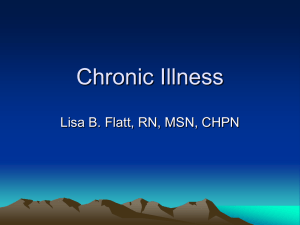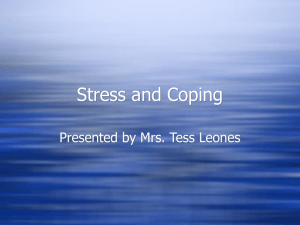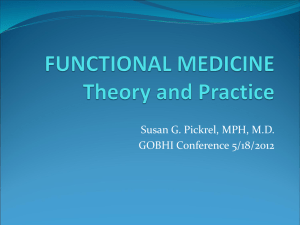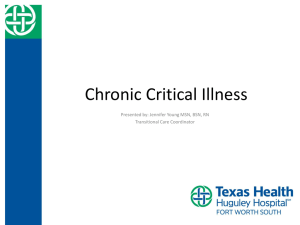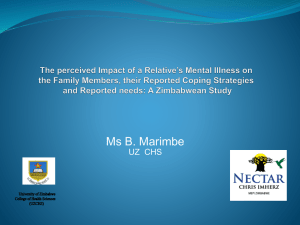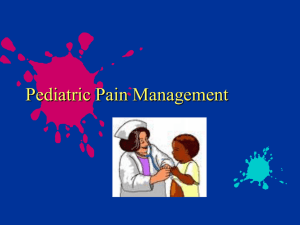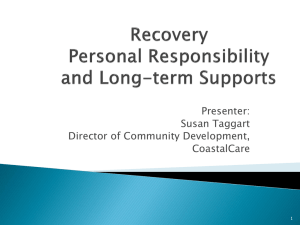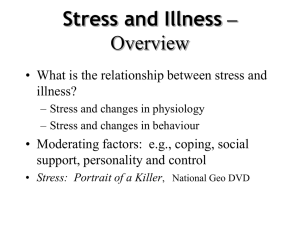Family Quality of Life
advertisement
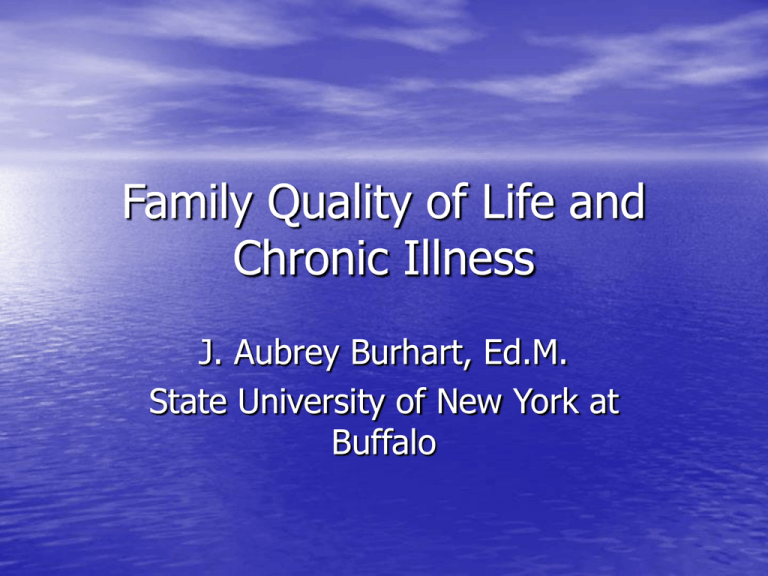
Family Quality of Life and Chronic Illness J. Aubrey Burhart, Ed.M. State University of New York at Buffalo Introduction • Growing recognition of quality of life parallels • • increasing medical knowledge and technology Improved longevity of nation as a whole leads to increased likelihood that more people will develop chronic illness (Lubkin & Larsen, 1998) When quantity of life is extended, quality of life needs to be considered. Defining Quality of life • No universally accepted definition • Subjective and objective components are typically included Defining Quality of Life • Ferrans (1985): “A person’s sense of well- being that stems from satisfaction or dissatisfaction with the areas of life that are important to him/her.” • Cella (1991): “Appraisal of and satisfaction with their current level of functioning as compared to what they perceive to be possible or ideal.” Recurrent Themes in definitions of QoL • Subjectivity: Numerous • Multidimensionality: Dimensions vary from author to author; common themes: physical, psychological, social, and spiritual wellbeing, economic impact • Interpersonal well-being: nonsupportive relationships, sense of not fulfilling family roles subjective attributes influence various domains – Physical well-being: feeling sick, slow or poor functioning, feeling dependent, fatigued or in pain • Psychological well-being: unable to concentrate, feeling insecure, questions/fears regarding disease Physical Issues • QoL is affected by the ability of chronically ill • • persons to continue in daily activities to avoid decreased self-esteem and autonomy Symptoms/Pain: Symptoms indicate whether disease is present or advancing; Patients who view pain as inevitable experience greater pain/more distress compared to those who perceived pain as a challenge (Barkwell, 1991) Patients’ families often perceive the patient’s pain to be greater than the patient’s themselves report Psychological Issues • Psychological well-being influences adjustment to chronic illness; General discomfort is thought to be negatively associated with life satisfaction and perceived coping ability • Searching for meaning: Finding some purpose; “Why me?” – People ascribe various meanings: • God has a plan • Unlucky • My family is now closer • I deserved this Social Issues • Chronic illness affects quality of patients’ social • • relationships and roles; Patients’ social support affects their QoL Patient support groups reinforce self-worth and promote adaptation Affect and affirmation from spouses and family correlated with less depression and improved marriage and family functioning (Primomo et al., 1990) Social Issues cont’d. • Social well-being contributes to QoL in many ways (Wortman, 1984): – Influences how meaning is ascribed to illness – Alters coping strategies used to manage stress – Influences motivation to employ adaptive behaviors – Promotes self-esteem – Protects individuals from negative effects of stress by altering their mood Social Issues cont’d. • For families, the goal is often “normalization” • Strategies families often employ to be perceived as “normal” include: (Knafl & Deatrick, 1986) – Engaging in activities that other families do – Limiting contacts with people who are similarly disabled or ill – Avoiding embarrassing situations – Controlling amount of information shared with others Factors that affect family QoL (Jassak & Knafl, 1990) • Family structure/interaction patterns • Availability of social networks • Potential for adaptation • Family philosophy such as beliefs, attitudes, values, and perceived stressors • Impact of illness Spiritual Issues • Spirituality differs from religiosity: “Spirituality” • • refers to innate, universal, human phenomenon; “Religiosity” refers to a system of beliefs and behaviors that reflect one’s spirituality Spiritual well-being is believed to be associated decreased frequently and amount of pain Belief in a higher being used as a coping mechanism by families Economic Issues • Chronic illness often precludes continued • • • employment Depending on amount of assistance person needs, the primary family caregiver may have to terminate employment Extra costs incurred for special food, medical supplies, therapy If family cannot afford assistance, family caregiver is likely to become overextended Family Caregivers (Lubkin & Larsen, 1998) • Providing care to another can enhance • • caregiver’s sense of efficacy and contribute to a positive self-image Caring for patient at home preserves some normalcy and can enhance QoL for patient and family When demands of providing care are perceived as exceeding available resources, caregivers experience stress, powerlessness, sometimes depression Family Caregivers • Stress for families results from uncertainty • • • regarding increased need for physical care over an indefinite period Families often report most extreme stress at onset of symptoms, awaiting diagnosis; Stress increases when client first moves in with caregiver Families face physical and intellectual changes in patient, loss of financial resources, loss of emotional support from individual Primary caregiver may have decreased social activities Family Caregivers • Burden of caregiving can increase over time • Various illnesses are associated with exhaustion, • fatigue, nervousness, and depression in primary caregiver, leading to increased risk for illness (heart disease, hypertension) Anxiety and guilt are prominent regarding person’s future health and eventual death, caregiver’s feelings of vulnerability and loss of control, effects of illness on other family members, distribution of finances, learning about member’s health problem and complex skills necessary for care, dealing with medical care providers Family Caregivers • Family might resort to criticism to motivate client • • • when angry and frustrated Parents QoL can be affected by pervasive feelings of guilt wondering if they caused the illness in a child Family may have to deal with patient’s anger and unrealistic demands; Family often swallows their natural response to anger which increases anxiety Families often undergo isolation and “loss of self” Chronic Disease – The nature of the challenge • About 10-15% of children under 16 years of age are affected by chronic illness • Many cannot be cured • Modern medicine can control pain, reduce intensity of symptoms, limit likelihood of long term complications • Every individual of child’s family will be changed due to this unexpected diagnosis Common Chronic Illnesses • • • • • • • Cystic fibrosis Spina bifida Leukemia Congenital heart disease Asthma Sickle cell disease Kidney Disease • • • • Diabetes Muscular Dystrophy Hemophilia Neurological Disease Concepts of Stress and Coping • Coping: “Constantly changing cognitive and behavioral efforts to manage specific external and/or internal demands that are appraised as taxing or exceeding the resources of the person” (Eiser, 1993, p.94) • Two ways of coping: – Attempting to change or control some aspect of the individual or environment (problem focused) – By managing or regulating the negative emotions associated with the stressor (emotion-focused) Mothers and Fathers • Mothers’ responses to chronic disease in their • • child have received an enormous amount of attention compared to other family members Mothers often take responsibility for sick child; Fathers take care of other siblings and maintain self-esteem through role as breadwinner These differentiations create task specific stressors for mothers and fathers Mothers mental health adjustment (Eiser, 1993) • More likely to be anxious and depressed • Report more mental and physical health complaints • Fear the child will hate them for the pain they inflict via administering treatments Factors that affect mothers’ mental health • Time since diagnosis • Age of child – preschool, adolescent age associated with more distress • Disease characteristics – fewer conclusive studies • Outside employment – dependent on reason for employment, implicit rewards in the work environment Fathers’ responses to chronic disease in their child • Appear less likely to respond by showing • • • • • • increased signs of depression and anxiety Understand less about the disease Less involved in everyday practical care However, less likely to be considered for promotion Fathers may interpret their role to be supporting their wife Contribute more with chores Buffer the effects of child’s chronic disease on mothers’ mental health Impact of Chronic Disease on Family relationships (Garrison & McQuiston, 1989) • Both siblings and mothers often exhibit • • increased levels of psychological distress and maladaptation. Marital disharmony, not divorce, is more common Specific family interaction patterns, such as overprotection and high levels of conflict, as well as parental psychological dysfunction have been associated with child adjustment problems Maintaining a Meaningful QoL: Tips for Clinicians • Provide families with disease-related information • • • • • and expected changes Seek out support groups for families with children with chronic illness Emphasize family strengths Draw out family expectations of client and others; Assist in the reintegration of their roles Validate the unpredictability, frustration, etc. Differentiate between wants and needs in order to avoid disappointment and complaints Maintaining a Meaningful QoL: Tips for Clinicians • Caregivers need a break! Encourage them to compromise on certain aspects of managing the house • Families need help re-managing money • Facilitate caregivers’ perceptions of respite as a reasonable and appropriate action, not personal failure Thank You! References Barkwell, D. (1991). Ascribed meaning: A critical factor in coping and pain attenuation in patients with cancer-related pain. Journal of Palliative Care, 7(3), 5-14. Eiser, C. (1993). Growing up with a chronic disease: The impact on children and their families. Philadelphia: Jessica Kingsley Publishers. Garrison, W. T., & McQuiston, S. (1989). Chronic illness during childhood and adolescence: Psychological aspects. London: Sage Publications. Jassak, P.F., & Knafl, K. A. (1990). Quality of family life: Exploration of a concept. Seminars in Oncology Nursing, 6, 298-302, Knafl, K. A., & Deatrick, J. A. (1986). How families manage chronic conditions: An analysis of the concept of normalization. Research in Nursing and Health, 9, 215-222. Lubkin, I. M., & Larsen, P. D. (1998). Chronic illness: Impacts and interventions. Massachusetts: Jones and Bartlett Publishers. Primomo, J., Yates, B. C., & Woods, N. E. (1990). Social support for women during chronic illness: The relationship among sources and types to adjustment. Research in Nursing and Health, 13(3), 153-161. Wortman, C. B., & Silver, R. C. (1992). Reconsidering assumptions about coping with loss: An overview of current research. In L. Montada et al. (eds.), Life crises and experiences of loss in adulthood. Hillsdale, NJ: Lawrence Erlbaum Associates.
